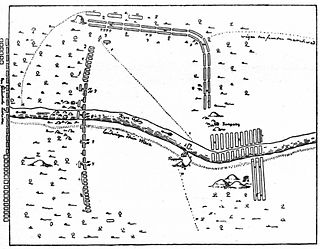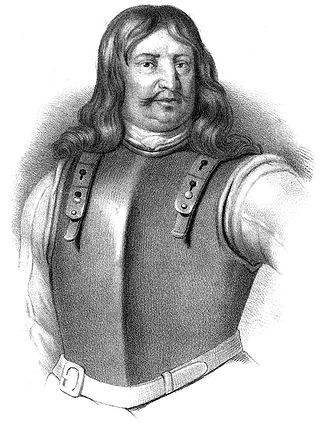
The Battle of Lesnaya was one of the major battles of the Great Northern War. It took place on October 9 [O.S. September 28] 1708 between a Russian army of between 17,000 and 29,000 men commanded by Peter I of Russia, Mikhail Mikhailovich Golitsyn, Aleksandr Danilovich Menshikov, Rudolph Felix Bauer and Nikolai Grigorovitj von Werden and a Swedish army between 12,500 and 16,000 men commanded by Adam Ludwig Lewenhaupt and Berndt Otto Stackelberg, at the village of Lesnaya, located close to the border between the Polish–Lithuanian Commonwealth and Russian Empire. The Swedes were escorting a supply column of more than 4,500 wagons for their main army in Ukraine.

In the Great Northern War (1700–1721) a coalition led by the Tsardom of Russia successfully contested the supremacy of the Swedish Empire in Northern, Central and Eastern Europe. The initial leaders of the anti-Swedish alliance were Peter I of Russia, Frederick IV of Denmark–Norway and Augustus II the Strong of Saxony–Poland–Lithuania. Frederick IV and Augustus II were defeated by Sweden, under Charles XII, and forced out of the alliance in 1700 and 1706 respectively, but rejoined it in 1709 after the defeat of Charles XII at the Battle of Poltava. George I of Great Britain and the Electorate of Hanover joined the coalition in 1714 for Hanover and in 1717 for Britain, and Frederick William I of Brandenburg-Prussia joined it in 1715.

The Battle of Poltava was the decisive and largest battle of the Great Northern War. The Russian army under the command of Tsar Peter I defeated the Swedish army under the command of Carl Gustaf Rehnskiöld. The battle put an end to the status of the Swedish Empire as a European great power, as well as its eastbound expansion, and marked the beginning of Russian supremacy in eastern Europe.

Count Fyodor Matveyevich Apraksin was one of the first Russian admirals, governed Estonia and Karelia from 1712 to 1723, was made general admiral (1708), presided over the Russian Admiralty from 1717 to 1728 and commanded the Baltic Fleet from 1723.

The Battle of Holowczyn was fought in July 1708 between the Russian army, and the Swedish army, led by Charles XII of Sweden, only 26 years of age at the time. Despite difficult natural obstacles and superior enemy artillery, the Swedes were able to achieve surprise and defeat the numerically superior Russian forces, who were separated from each other, had no overall command and could not coordinate their actions, disallowing them an engagement in full force. Reportedly, it was Charles' favourite victory.

The Battle of Gangut took place on 27 JulyJul./ 7 August 1714Greg. during the Great Northern War (1700–1721), in the waters of Riilahti Bay, north of the Hanko Peninsula, near the site of the modern-day city of Hanko, Finland, between the Swedish Navy and Imperial Russian Navy. It was the first important victory of the Russian fleet in its history. It is commemorated in Russia as one of the Days of Military Honour.

The Battle of Napue or the Battle of Storkyro / Isokyrö was fought on 19 February 1714 (O.S.) / 2 March 1714 (N.S.) at the villages of Napue and Laurola in the Isokyrö parish of the Swedish Empire between the Swedish Empire and the Tsardom of Russia. It was the final land battle of the Finnish campaign in the Great Northern War. The Swedish detachment, consisting almost entirely of Finnish troops, were defeated by the numerically superior Russian force. As a result, all of Finland fell under Russian military occupation for the rest of the War; a seven-year period of hardship known in Finland as the Great Wrath.

The invasion of Russia by Charles XII of Sweden was a campaign undertaken during the Great Northern War between Sweden and the allied states of Russia, Poland, and Denmark. The invasion began with Charles's crossing of the Vistula on 1 January 1708, and effectively ended with the Swedish defeat in the Battle of Poltava on 8 July 1709, though Charles continued to pose a military threat to Russia for several years while under the protection of the Ottoman Turks.

The Battle of Molyatichi, also known as the Battle of Dobroye, took place on August 31, 1708 at Molyatichi during the Great Northern War. The Russian army of Peter the Great under the command of Mikhail Golitsyn launched a surprise attack on the isolated vanguard of Charles XII's Swedish Army, under the direct command of Carl Gustaf Roos, in order to destroy it. Their cavalry was unable to arrive in time to cut Roos' command off before Swedish reinforcements arrived, forcing the Russians to retreat.

Georg Lybecker was a Swedish friherre and lieutenant general of the Swedish Army, he was son to Georg Henrik Lybecker and Catharina Grissbach. He died on 4 June 1718 at Värsta, Närke.

The Battle of Pälkäne, sometimes called the Battle at Kostianvirta or Battle on the Pialkiane River was fought between the Russian army under Admiral Fyodor Apraksin and the defending Finnish army of Sweden under General Carl Gustaf Armfeldt on 17 October 1713, as part of the Great Northern War. It resulted in a Russian victory, although General Armfeldt was able to withdraw his army in good order.

The siege of Viborg took place in the spring of 1710 during the Great Northern War (1700–1721), as a second attempt by the Russians to capture the fortress port of Viborg, near the modern border between Russia and Finland, after a failed attempt in 1706. After the outbreak of the war, Swedish forces had fortified themselves in the port of Viborg. In order to assure safety for the newly founded city of Saint Petersburg, Peter the Great ordered the Swedish fort to be secured. A first unsuccessful attempt was made in 1706. Later plans were put on hold because of other ongoing conflicts but, after the Russian success at the Battle of Poltava in June 1709, the men and resources were available to capture the town.

The Battle of Krasnokutsk–Gorodnoye took place on February 20–22, 1709, in the Swedish campaign of Russia during the Great Northern War. The Swedish troops were directly led by Charles XII of Sweden who pursued a force of Russians commanded by Otto Rudolf von der Schaumburg from the minor battle of Krasnokutsk to the town of Gorodnoye (Horodnje) where a new battle took place, with the Russians now commanded by Karl Evald von Rönne. The Swedes were victorious but cancelled their offensive as night fell.

The Battle of Uttismalm took place on June 28, 1789 during Gustav III's Russian War, Sweden won over the Russian Empire.
The Battle of Walk on July 8, 1657 between forces of Sweden commanded by Friedrich von Löwen on one side, and Russian forces led by stolnik Matvey Sheremetyev, who for the first time in his career commanded an army by himself, on the other side. The largest part of the Russian army disobeyed Sheremetyev and left the battle at the beginning, forcing him to rely on the 250 reiters of Colonel Denis Fonvizin, who played the key role in the breakthrough and allowed the rest of the army to escape. The Swedish forces won the battle, and according to their sources they defeated an army of 8,000 men, 32 standards, banners and other field declarations had been captured in the battle and 1,500 Russians were dead or wounded along with their commander Matvey Sheremetyev, who later died in captivity. In comparison, some 12 Swedes, including Lieutenant Captain Tiesenhusen, were killed.

The Campaign of Grodno was a plan developed by Johann Patkul and Otto Arnold von Paykull during the Swedish invasion of the Polish–Lithuanian Commonwealth, a part of the Great Northern War. Its purpose was to crush Charles XII's army with overwhelming force in a combined offensive of Russian and Saxon troops. The campaign, executed by Peter I of Russia and Augustus II of Saxony, began in July 1705 and lasted almost a year. In divided areas the allies would jointly strike the Swedish troops occupied in Poland, in order to neutralize the influence the Swedes had in the Polish politics. However, the Swedish forces under Charles XII successfully outmaneuvered the allies, installed a Polish king in favor of their own and finally won two decisive victories at Grodno and Fraustadt in 1706. This resulted in the Treaty of Altranstädt (1706) in which Augustus renounced his claims to the Polish throne, broke off his alliance with Russia, and established peace between Sweden and Saxony.
The Evacuation of Kolkanpää took place between October 18 and 27, 1708, close to Kolkanpää, in the Swedish Empire during the Great Northern War. The Swedes under the command of Georg Lybecker were evacuating their Finnish-based army consisting of up to 11,279 men back to Finland after their failed campaign in Swedish Ingria in an attempt to recover land previously lost to Russia. Fyodor Apraksin, the Russian commander in the area, decided to interrupt the evacuation with between 3,000 and 3,500 men. He decided to wait until only a portion, between 600 and 800 Saxon ex-prisoners recruited into Swedish service, remained on the beaches not yet evacuated before commencing attack with all his troops. After several assaults the Saxons were soon overwhelmed and almost all of them were cut down or captured by the end of the battle. About 50 Russians were killed and 220 wounded. The Swedes were also forced to slaughter about 4,000 of their horses which could not be evacuated so they would not fall into Russian hands.

The Battle of Koporye took place on October 8, 1708 close to Koporye, in the Swedish Empire during the Ingrian campaign in the Great Northern War. A Swedish force consisting of 1,800 men under the command of generals Carl Gustaf Armfeldt and Anders Erik Ramsay attacked a numerically stronger enemy of between 2,000 and 3,000 Russian forces. The battle ended in a Swedish victory with about 600 Russians killed and only 70 dead among the Swedish force. After further campaigning, the Swedish–Finland army under the command of Georg Lybecker decided to evacuate his troops, having failed at his objectives.

The Great Northern War in Ukraine (1708–1713) — war between the Tsardom of Russia on one hand and the Swedish Empire and the Ottoman Empire on the other.

The Battle of Helsinki was fought between the Russian army under Tsar Peter the Great and Admiral Fyodor Apraksin and the defending Finnish army of Sweden under General Carl Gustaf Armfeldt between 8 and 11 May 1713, as part of the Great Northern War. It resulted in a Russian victory, leading to the Swedes commanded by Armfelt burning the entire city of Helsinki when retreating. Destroyed after the actual battle, the city changed hands twice more in the following months until it remained permanently in the hands of the Russians.















